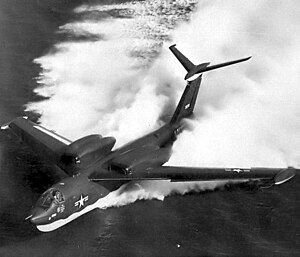Martin P6M
| Martin P6M SeaMaster | |
|---|---|
 P6M-2 SeaMaster at startup |
|
| Type: | Four-engine flying boat |
| Design country: | |
| Manufacturer: | |
| First flight: |
July 14, 1955 |
| Commissioning: |
Flight tests canceled in 1959 |
| Production time: |
Was never mass-produced |
| Number of pieces: |
12 |
The Martin P6M SeaMaster was a four- engine flying boat of the US Navy from 1956. It was to be used as a strategic bomber for the US Navy with nuclear weapons . Due to the high construction costs and the possibilities offered by the new Polaris ballistic submarine missiles, the project was abandoned in 1959.
prehistory
In the early phase of the Cold War was the US Air Force , the main task in the nuclear strategy of the United States assigned. The US Navy saw its prestige and budget in danger. The first attempt to counter this was the plan to build the aircraft carrier USS United States , which would carry bombers with nuclear weapons. However, he fell victim to budget cuts. The Navy now called for the construction of strategic flying boats, as these are quick to move and difficult to locate.
history
In April 1951, the tender for a strategic flying boat was published. It should be from maritime bases from 13,600 kg bombs to targets in max. Fly 2,400 km away and reach Mach 0.9 (1,010 km / h) at low altitudes . Consolidated Vultee Aircraft Corporation and Martin submitted designs. Martin was awarded the contract to build two prototypes. Six pre-series machines and 24 series flying boats were planned.
Martin based its development on numerous structural features of the Martin XB-51 jet bomber . The aircraft was sturdily built, the wing paneling reached a thickness of 25 mm at the wing root. The first prototype was to be equipped with Curtiss-Wright turbo ramjet engines. For problems they opted for a more conventional Allison J71-A-4 - Turbojet -Triebwerk. The engines were placed in pairs on the wings. The wings were swept 40 ° and inclined slightly forward. The rotating bomb bays were protected against ingress of seawater by overpressure.
The first flight of the XP6M-1 took place on July 14, 1955. It became apparent that the engines were mounted too close to the fuselage: the afterburners burned parts of the fuselage. On December 17, 1955, the prototype crashed due to a failure of the control instruments; the four crew members died. The second prototype crashed on November 9, 1956 after an error in the control system. The crew was able to save themselves with ejection seats.
The first pre-series machine YP6M-1 was completed a year later and began test flights in January 1958. Five more pre-series machines followed, which carried out test flights with full weapons equipment. The program proved to be successful, the first series machine P6M-2 was delivered in early 1959. It had more powerful Pratt & Whitney J75 P-2 engines, better aerodynamics, a cockpit with better pilot visibility and could be refueled in the air . The refueling system was fitted into the bomb bay. The P6M-2 reached Mach 0.9 (1,010 km / h). Only a few aircraft of the time achieved this speed (a USAF Boeing B-52 could only reach 670 km / h at low altitude).
By the summer of 1959, three machines had been built and Navy crews trained. However, on August 21, 1959, the program was stopped. A manned bomber for transporting nuclear weapons had become too expensive. The P6M cost the US around $ 400 million. All planes were scrapped. Some parts are now in the Glenn L. Martin Museum. Some of the swimmers were converted into a catamaran by Martin employees .
The P6M was the last Glenn L. Martin Company aircraft. The company failed in civil aircraft construction and turned to the construction of missiles and electronic components.
Technical specifications
| Parameter | Data |
|---|---|
| length | 40.84 m |
| span | 31.37 m |
| Wing area | 180 m² |
| height | 9.88 m |
| drive | four Pratt & Whitney J75 P-2 turbojet engines, each 76.5 kN of thrust |
| Top speed | 1,010 km / h |
| Range | 3,200 km |
| crew | 4th |
| Service ceiling | 12,000 m |
| Empty mass | 41,400 kg |
| Flight mass | 54,000 kg |
| Max. Mass in flight | 80,000 kg |
| Armament | two 20 mm cannons in the stern, 14,000 kg bombs |
Web links
